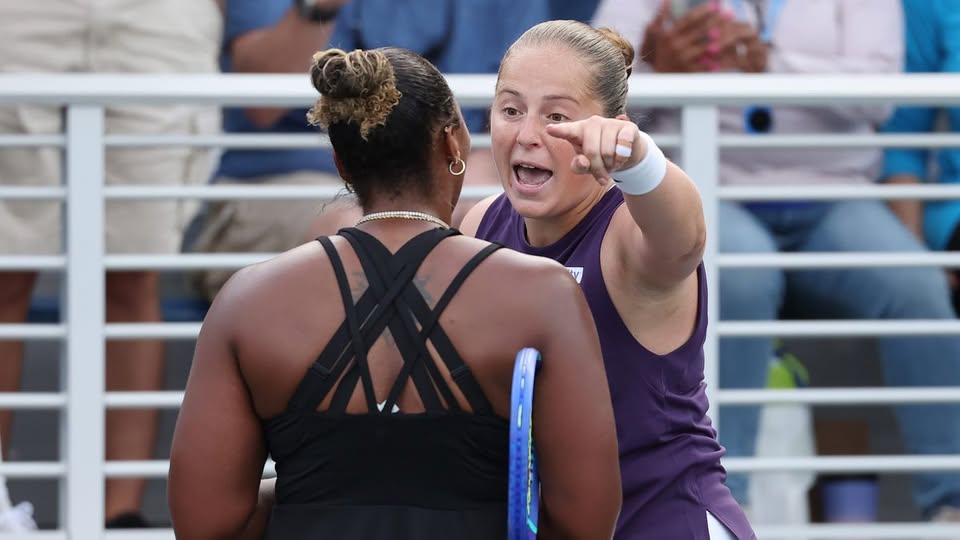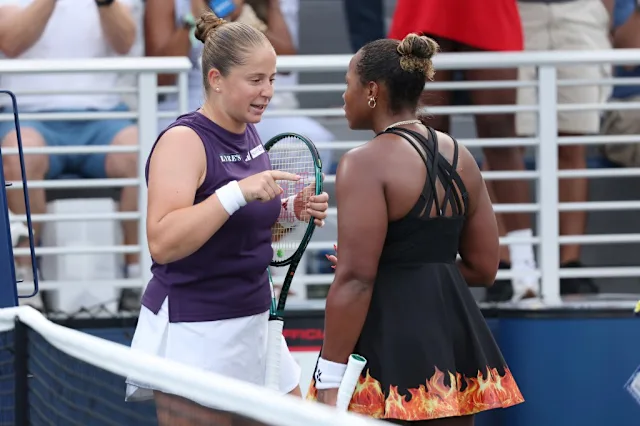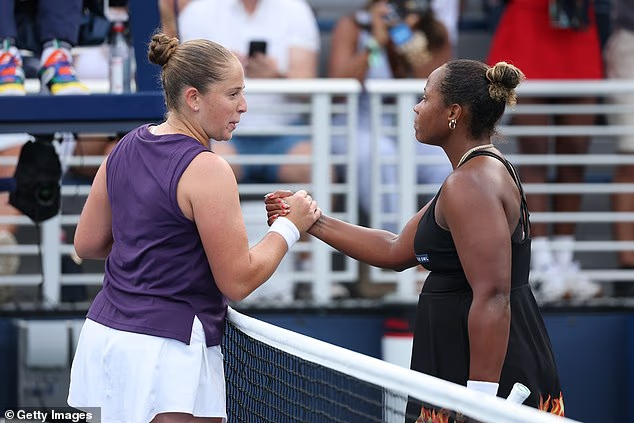🔥 A Handshake That Turned Into Headlines
What should have been a routine handshake after a second-round match at the U.S. Open turned into one of the tournament’s most explosive storylines. Jelena Ostapenko, 28, had just fallen 7-5, 6-1 to American Taylor Townsend, 29, when she let her opponent know exactly how she felt. The Latvian star accused Townsend of being “disrespectful” and breaking the “rules of tennis,” igniting a war of words that quickly spread beyond the court.

Tennis fans are used to rivalries, but this one wasn’t about aces and winners—it was about sportsmanship, etiquette, and how much those unwritten traditions still matter in today’s game.
🎾 Ostapenko’s Claims: Breaking the Unspoken Code
Ostapenko wasted no time sharing her perspective. In a series of Instagram posts, she said she was upset by two things Townsend did:
- The net cord moment. Townsend won a crucial point when her shot clipped the net and dropped in. Ostapenko expected the customary “sorry,” a small gesture of sportsmanship, but none came.
- The warm-up routine. According to Ostapenko, players are supposed to start warm-ups from the baseline before moving forward. She accused Townsend of jumping straight to the net, calling it disrespectful and against tradition.
Her frustration was clear: “If she plays in her homeland it doesn’t mean that she can behave and do whatever she wants.”
Video : Tensions Flare in a Match That No One Will Forget
💬 Townsend Fires Back: ‘Your Expectations, Not Mine’
Townsend wasn’t having it. In her post-match press conference, she pushed back hard against the idea that she had to follow Ostapenko’s unwritten rules.
“If you expect for someone to apologize and they don’t and you get upset about it, that’s your fault, not mine,” she said.
For Townsend, a net cord is part of the game, not an offense that demands an apology. She made it clear: she wasn’t going to let another player’s expectations dictate her behavior.
⚡ The Accusations Escalate
The situation intensified when Ostapenko revealed she’d received online messages accusing her of racism. She strongly denied the claims, insisting her frustration had nothing to do with race:
“I was NEVER racist in my life and I respect all nations of people in the world. There are some rules in tennis and unfortunately when the crowd is with you, you can’t use it in a disrespectful way to your opponent.”

Townsend, when asked, said she didn’t interpret Ostapenko’s words as racially motivated but admitted that remarks about “no education” or “no class” hit on long-standing stereotypes her community has had to fight against.
🔥 Ostapenko’s Fiery Reputation
This wasn’t Ostapenko’s first brush with controversy. Her emotional, fiery style has made headlines before, including a refusal to shake hands with Victoria Azarenka at the Qatar Open in 2023. Love her or hate her, Ostapenko is known for wearing her emotions on her sleeve—and this latest episode only cements that reputation.
🤔 Sportsmanship or Competition? The Bigger Debate
This dustup has sparked a broader conversation: are these “unwritten rules” in tennis still relevant?
- For some, gestures like apologizing after a net cord are essential to maintaining the spirit of respect in tennis.
- For others, they’re outdated courtesies that have no bearing on the actual rules of the game.
Video : Jelena Ostapenko says ‘disrespectful’ Taylor Townsend broke ‘rules of tennis’ before US Open dustup
Townsend’s stance challenges the very idea that courtesy should be enforced, while Ostapenko’s reaction reflects the weight many players still put on tradition.
👀 Fans and Media React
As expected, the tennis world lit up. Social media users took sides, with some calling Ostapenko “right about etiquette” and others applauding Townsend for refusing to bend to “fake politeness.” Analysts and commentators debated whether sportsmanship in tennis is evolving—or eroding.
It wasn’t just about the match anymore. It became a referendum on respect, culture, and how players should navigate the line between tradition and individuality.
🏆 Conclusion: More Than Just a Match
The scoreline may read 7-5, 6-1 in Townsend’s favor, but the real story was what happened after the final point. Ostapenko versus Townsend will be remembered not for its rallies, but for the fiery handshake and the heated words that followed.

At its heart, this clash wasn’t just about two players—it was about tennis itself. Should players still honor unspoken rules, or is it time for the sport to move past them?
One thing is certain: the Ostapenko-Townsend dustup gave the U.S. Open one of its most unforgettable off-court moments—proof that in tennis, the drama doesn’t always end when the ball stops bouncing.